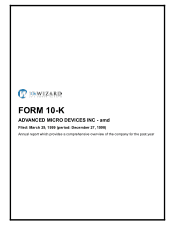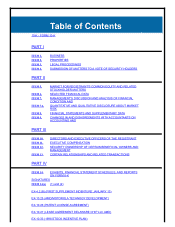AMD 1998 Annual Report Download - page 10
Download and view the complete annual report
Please find page 10 of the 1998 AMD annual report below. You can navigate through the pages in the report by either clicking on the pages listed below, or by using the keyword search tool below to find specific information within the annual report.significant capital expenditures to support our microprocessor products both
in the near and long term. Our ability to increase microprocessor product
revenues, and benefit fully from the substantial financial investments and
commitments that we have made and continue to make related to microprocessors,
depends upon the success of the AMD-K6 and AMD-K6-III microprocessors with
3DNow! technology, the AMD-K7(TM) microprocessor, which is our seventh-
generation, Microsoft Windows compatible microprocessor planned for
introduction by the end of the first half of 1999, and future generations of
K86 microprocessors. The microprocessor market is characterized by short
product life cycles and migration to ever higher performance microprocessors.
To compete successfully against Intel in this market, we must transition to
new process technologies at a faster pace than before and offer higher
performance microprocessors in significantly greater volumes.
Intel has dominated the market for microprocessors used in PCs for a long
time. Because of its dominant market position, Intel can set and control x86
microprocessor standards and, thus, dictate the type of product the market
requires of Intel's competitors. In addition, Intel may vary prices on its
microprocessors and other products at will and thereby affect the margins and
profitability of its competitors due to its financial strength and dominant
position. Given Intel's industry dominance and brand strength, Intel's
decisions on processor prices can impact and have impacted the average selling
prices of the AMD-K6 microprocessors, and consequently can impact and has
impacted our margins. As an extension of its dominant microprocessor market
share, Intel also now dominates the PC platform. As a result, it is difficult
for PC manufacturers to innovate and differentiate their product offerings. We
do not have the financial resources to compete with Intel on such a large
scale.
As Intel has expanded its dominance over the entirety of the PC system
platform, many PC original equipment manufacturers (OEMs) have reduced their
system development expenditures and have purchased microprocessors in
conjunction with core logic chipsets or in assembled motherboards. PC OEMs are
becoming increasingly dependent on Intel, less innovative on their own and
more of a distribution channel for Intel technology. In marketing our
microprocessors to these OEMs and dealers, we depend upon companies other than
Intel for the design and manufacture of chipsets, motherboards, basic
input/output system (BIOS) software and other components. In recent years,
these third-party designers and manufacturers have lost significant market
share to Intel. In addition, these companies produce chipsets, motherboards,
BIOS software and other components to support each new generation of Intel's
microprocessors only if Intel makes information about its products available
to them in time to address market opportunities. Delay in the availability of
such information makes, and will continue to make, it increasingly difficult
for these third parties to retain or regain market share. To compete with
Intel in this market in the future, we intend to continue to form closer
relationships with third-party designers and manufacturers of chipsets,
motherboards, BIOS software and other components. Similarly, we intend to
expand our chipset and system design capabilities, and to offer OEMs licensed
system designs incorporating our processors and companion products. We cannot
be certain, however, that our efforts will be successful.
Our AMD K-6 microprocessors are based on the Nx686 microprocessor developed
by NexGen, Inc. (NexGen). NexGen was founded in 1986 to design and market high
performance microprocessors. In September 1994, NexGen began shipping its
Nx586 processor to customers. In October 1995, NexGen announced the Nx686
processor technology. However, NexGen never introduced an Nx686 or other
sixth-generation product in the market. On January 17, 1996, we acquired
NexGen in a tax-free reorganization in which NexGen was merged directly into
AMD and all operations of NexGen were integrated into CPG. The merger was
accounted for under the pooling-of-interests method.
Memory Group
Memory Group products ($561 million, or 22 percent, of our 1998 net sales)
include Flash memory devices and EPROMs.
Flash Memory. Our Flash memory devices are used in cellular telephones,
networking equipment and other applications which require memory to be non-
volatile and rewritten. These Flash memory devices may be electrically
rewritten. This feature provides greater flexibility and ease of use than
EPROMs and other similar integrated circuits which cannot be electrically
rewritten. Communications companies use Flash memory devices
7
Source: ADVANCED MICRO DEVIC, 10-K, March 29, 1999























